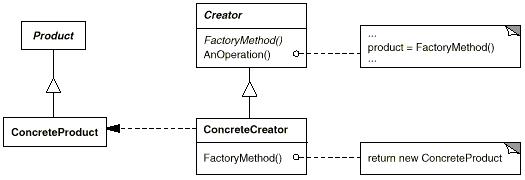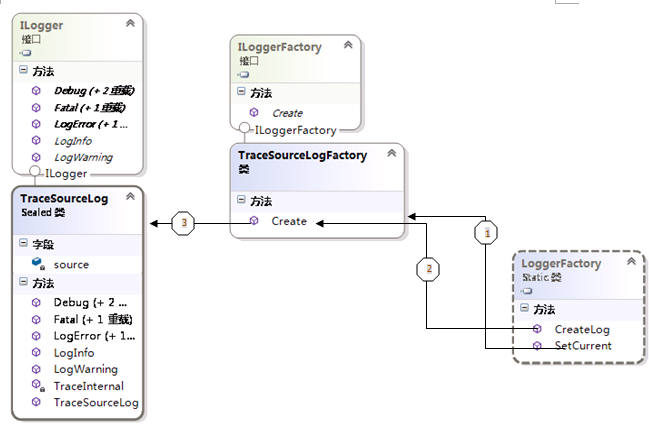微软常用的组件设计思想-‘工厂的工厂类’
2018-06-17 19:16:45来源:未知 阅读 ()

我们在写代码的时候,经常碰到各种软件的设计思想,也许,你是一个弱小的码农,也逃不了设计的思想已悄悄的走向你的身边,只是我们不知道这叫啥罢了。
诸如,我们经常玩的三层BLL DAL UI 那么还有一个东东,就是工厂Factory起到桥接作用。
回忆起三层,Factory 是一种设计模式
工厂方法模式的结构图如下:

Product定义了工厂方法所创建的对象的接口。
ConcreteProduct实现Product接口, 定义了具体对象。
Creator定义了具体对象创建的工厂方法,该方法返回一个Product类型的对象。Creator也可以定义一个工厂方法的缺省实现,它返回一个缺省的ConcreteProduct对象
ConcreteCreator实现Creator接口,重定义工厂方法以返回一个ConcreteProduct实例。
示例
我们以实现一个文档处理系统来看一下工厂方法模式的应用。
首先定义文档类型的接口和两个具体的文档类型
1 public interface IFile
2 {
3 void New();
4 void Save();
5 }
6 public class DocFile : IFile
7 {
8 public void New()
9 {
10 Console.WriteLine("New Doc Create");
11 }
12 public void Save()
13 {
14 Console.WriteLine("Save Doc");
15 }
16 }
17 public class TxtFile : IFile
18 {
19 public void New()
20 {
21 Console.WriteLine("New Txt Create");
22 }
23 public void Save()
24 {
25 Console.WriteLine("Save Txt");
26 }
27 }
接着实现对象创建的工厂方法及具体文档的创建工厂
1 interface IFileFactory
2 {
3 IFile Create();
4 }
5 public class DocFileFactory : IFileFactory
6 {
7 public IFile Create()
8 {
9 return new DocFile();
10 }
11 }
12 public class TxtFileFactory : IFileFactory
13 {
14 public IFile Create()
15 {
16 return new TxtFile();
17 }
18 }
最后看一下如何调用
1 static void Main(string[] args)
2 {
3 IFile docFile = (new DocFileFactory()).Create();
4 docFile.New();
5 docFile.Save();
6 IFile txtFile = (new TxtFileFactory()).Create();
7 txtFile.New();
8 txtFile.Save();
9 Console.ReadLine();
10 }
回忆到此,想必,大家对工厂有个很好的体会了,不过,今天,我们看看微软是如何在工厂的基础上动手脚的

上图是微软最喜欢用的工厂设计模式思想(此例为日志工厂)。
我们来分析上面的思路
1)为了能够使程序在加载的时候,动态适应改变不同的工厂,而引入了LoggerFactory工厂类
2)减轻了每次在代码中去重复的指定工厂实现类
3)上图中,第一步通过LoggerFactory工厂类SetCurrent()指定当前工厂实现类TraceSourceLogFactory
4) LoggerFactory工厂类调用方法CreateLog()直接调用TraceSourceLogFactory工厂类Create(),进而创建出TraceSourceLog 现实类
我们来看看具体的代码:
1)ILogger接口:
public interface ILogger { /// <summary> /// Log debug message /// </summary> /// <param name="message">The debug message</param> /// <param name="args">the message argument values</param> void Debug(string message, params object[] args); /// <summary> /// Log debug message /// </summary> /// <param name="message">The message</param> /// <param name="exception">Exception to write in debug message</param> void Debug(string message,Exception exception,params object[] args); /// <summary> /// Log debug message /// </summary> /// <param name="item">The item with information to write in debug</param> void Debug(object item); /// <summary> /// Log FATAL error /// </summary> /// <param name="message">The message of fatal error</param> /// <param name="args">The argument values of message</param> void Fatal(string message, params object[] args); /// <summary> /// log FATAL error /// </summary> /// <param name="message">The message of fatal error</param> /// <param name="exception">The exception to write in this fatal message</param> void Fatal(string message, Exception exception,params object[] args); /// <summary> /// Log message information /// </summary> /// <param name="message">The information message to write</param> /// <param name="args">The arguments values</param> void LogInfo(string message, params object[] args); /// <summary> /// Log warning message /// </summary> /// <param name="message">The warning message to write</param> /// <param name="args">The argument values</param> void LogWarning(string message, params object[] args); /// <summary> /// Log error message /// </summary> /// <param name="message">The error message to write</param> /// <param name="args">The arguments values</param> void LogError(string message, params object[] args); /// <summary> /// Log error message /// </summary> /// <param name="message">The error message to write</param> /// <param name="exception">The exception associated with this error</param> /// <param name="args">The arguments values</param> void LogError(string message, Exception exception, params object[] args); }
2)日志接口TraceSourceLog实现类:
public sealed class TraceSourceLog :ILogger { #region Members TraceSource source; #endregion #region Constructor /// <summary> /// Create a new instance of this trace manager /// </summary> public TraceSourceLog() { // Create default source source = new TraceSource("NLayerApp"); } #endregion #region Private Methods /// <summary> /// Trace internal message in configured listeners /// </summary> /// <param name="eventType">Event type to trace</param> /// <param name="message">Message of event</param> void TraceInternal(TraceEventType eventType, string message) { if (source != null) { try { source.TraceEvent(eventType, (int)eventType, message); } catch (SecurityException) { //Cannot access to file listener or cannot have //privileges to write in event log etc... } } } #endregion #region ILogger Members /// <summary> /// <see cref="Microsoft.Samples.NLayerApp.Infrastructure.Crosscutting.Logging.ILogger"/> /// </summary> /// <param name="message"><see cref="Microsoft.Samples.NLayerApp.Infrastructure.Crosscutting.Logging.ILogger"/></param> /// <param name="args"><see cref="Microsoft.Samples.NLayerApp.Infrastructure.Crosscutting.Logging.ILogger"/></param> public void LogInfo(string message, params object[] args) { if (!String.IsNullOrWhiteSpace(message)) { var messageToTrace = string.Format(CultureInfo.InvariantCulture, message, args); TraceInternal(TraceEventType.Information, messageToTrace); } } /// <summary> /// <see cref="Microsoft.Samples.NLayerApp.Infrastructure.Crosscutting.Logging.ILogger"/> /// </summary> /// <param name="message"><see cref="Microsoft.Samples.NLayerApp.Infrastructure.Crosscutting.Logging.ILogger"/></param> /// <param name="args"><see cref="Microsoft.Samples.NLayerApp.Infrastructure.Crosscutting.Logging.ILogger"/></param> public void LogWarning(string message, params object[] args) { if (!String.IsNullOrWhiteSpace(message)) { var messageToTrace = string.Format(CultureInfo.InvariantCulture, message, args); TraceInternal(TraceEventType.Warning, messageToTrace); } } /// <summary> /// <see cref="Microsoft.Samples.NLayerApp.Infrastructure.Crosscutting.Logging.ILogger"/> /// </summary> /// <param name="message"><see cref="Microsoft.Samples.NLayerApp.Infrastructure.Crosscutting.Logging.ILogger"/></param> /// <param name="args"><see cref="Microsoft.Samples.NLayerApp.Infrastructure.Crosscutting.Logging.ILogger"/></param> public void LogError(string message, params object[] args) { if (!String.IsNullOrWhiteSpace(message)) { var messageToTrace = string.Format(CultureInfo.InvariantCulture, message, args); TraceInternal(TraceEventType.Error, messageToTrace); } } /// <summary> /// <see cref="Microsoft.Samples.NLayerApp.Infrastructure.Crosscutting.Logging.ILogger"/> /// </summary> /// <param name="message"><see cref="Microsoft.Samples.NLayerApp.Infrastructure.Crosscutting.Logging.ILogger"/></param> /// <param name="exception"><see cref="Microsoft.Samples.NLayerApp.Infrastructure.Crosscutting.Logging.ILogger"/></param> /// <param name="args"><see cref="Microsoft.Samples.NLayerApp.Infrastructure.Crosscutting.Logging.ILogger"/></param> public void LogError(string message, Exception exception, params object[] args) { if (!String.IsNullOrWhiteSpace(message) && exception != null) { var messageToTrace = string.Format(CultureInfo.InvariantCulture, message, args); var exceptionData = exception.ToString(); // The ToString() create a string representation of the current exception TraceInternal(TraceEventType.Error, string.Format(CultureInfo.InvariantCulture, "{0} Exception:{1}", messageToTrace, exceptionData)); } } /// <summary> /// <see cref="Microsoft.Samples.NLayerApp.Infrastructure.Crosscutting.Logging.ILogger"/> /// </summary> /// <param name="message"><see cref="Microsoft.Samples.NLayerApp.Infrastructure.Crosscutting.Logging.ILogger"/></param> /// <param name="args"><see cref="Microsoft.Samples.NLayerApp.Infrastructure.Crosscutting.Logging.ILogger"/></param> public void Debug(string message, params object[] args) { if (!String.IsNullOrWhiteSpace(message)) { var messageToTrace = string.Format(CultureInfo.InvariantCulture, message, args); TraceInternal(TraceEventType.Verbose, messageToTrace); } } /// <summary> /// <see cref="Microsoft.Samples.NLayerApp.Infrastructure.Crosscutting.Logging.ILogger"/> /// </summary> /// <param name="message"><see cref="Microsoft.Samples.NLayerApp.Infrastructure.Crosscutting.Logging.ILogger"/></param> /// <param name="exception"><see cref="Microsoft.Samples.NLayerApp.Infrastructure.Crosscutting.Logging.ILogger"/></param> /// <param name="args"><see cref="Microsoft.Samples.NLayerApp.Infrastructure.Crosscutting.Logging.ILogger"/></param> public void Debug(string message, Exception exception,params object[] args) { if (!String.IsNullOrWhiteSpace(message) && exception != null) { var messageToTrace = string.Format(CultureInfo.InvariantCulture, message, args); var exceptionData = exception.ToString(); // The ToString() create a string representation of the current exception TraceInternal(TraceEventType.Error, string.Format(CultureInfo.InvariantCulture, "{0} Exception:{1}", messageToTrace, exceptionData)); } } /// <summary> /// <see cref="Microsoft.Samples.NLayerApp.Infrastructure.Crosscutting.Logging.ILogger"/> /// </summary> /// <param name="item"><see cref="Microsoft.Samples.NLayerApp.Infrastructure.Crosscutting.Logging.ILogger"/></param> public void Debug(object item) { if (item != null) { TraceInternal(TraceEventType.Verbose, item.ToString()); } } /// <summary> /// <see cref="Microsoft.Samples.NLayerApp.Infrastructure.Crosscutting.Logging.ILogger"/> /// </summary> /// <param name="message"><see cref="Microsoft.Samples.NLayerApp.Infrastructure.Crosscutting.Logging.ILogger"/></param> /// <param name="args"><see cref="Microsoft.Samples.NLayerApp.Infrastructure.Crosscutting.Logging.ILogger"/></param> public void Fatal(string message, params object[] args) { if (!String.IsNullOrWhiteSpace(message)) { var messageToTrace = string.Format(CultureInfo.InvariantCulture, message, args); TraceInternal(TraceEventType.Critical, messageToTrace); } } /// <summary> /// <see cref="Microsoft.Samples.NLayerApp.Infrastructure.Crosscutting.Logging.ILogger"/> /// </summary> /// <param name="message"><see cref="Microsoft.Samples.NLayerApp.Infrastructure.Crosscutting.Logging.ILogger"/></param> /// <param name="exception"><see cref="Microsoft.Samples.NLayerApp.Infrastructure.Crosscutting.Logging.ILogger"/></param> public void Fatal(string message, Exception exception,params object[] args) { if (!String.IsNullOrWhiteSpace(message) && exception != null) { var messageToTrace = string.Format(CultureInfo.InvariantCulture, message, args); var exceptionData = exception.ToString(); // The ToString() create a string representation of the current exception TraceInternal(TraceEventType.Critical, string.Format(CultureInfo.InvariantCulture, "{0} Exception:{1}", messageToTrace, exceptionData)); } } #endregion }
3) ILoggerFactory接口:
/// <summary> /// Base contract for Log abstract factory /// </summary> public interface ILoggerFactory { /// <summary> /// Create a new ILog /// </summary> /// <returns>The ILog created</returns> ILogger Create(); }
4)TraceSourceLogFactory 接口ILoggerFactory实现类
/// <summary> /// A Trace Source base, log factory /// </summary> public class TraceSourceLogFactory :ILoggerFactory { /// <summary> /// Create the trace source log /// </summary> /// <returns>New ILog based on Trace Source infrastructure</returns> public ILogger Create() { return new TraceSourceLog(); } }
5)LoggerFactory 工厂类
/// <summary> /// Log Factory /// </summary> public static class LoggerFactory { #region Members static ILoggerFactory _currentLogFactory = null; #endregion #region Public Methods /// <summary> /// Set the log factory to use /// </summary> /// <param name="logFactory">Log factory to use</param> public static void SetCurrent(ILoggerFactory logFactory) { _currentLogFactory = logFactory; } /// <summary> /// Createt a new <paramref name="Microsoft.Samples.NLayerApp.Infrastructure.Crosscutting.Logging.ILog"/> /// </summary> /// <returns>Created ILog</returns> public static ILogger CreateLog() { return (_currentLogFactory != null) ? _currentLogFactory.Create() : null; } #endregion }
在全局的项目配置里加入设置当前工厂方法

细心的朋友可以看出,下面还有其它类似的工厂,哈哈,换汤不换药。
调用: LoggerFactory.CreateLog().LogError(Messages.error_CannotPerformTransferInvalidAccounts);
小结:设计的思想,就是从人的思想角度出发,驱动代码的构造。好的设计思想,往往都是从代码中提炼而来,从而推动了更优秀的设计思想,不断的创新迭出!
做为程序员多看看优质的源码,可以快速的吸收别人的精髓,这也是一种‘智取’。
出处:http://www.cnblogs.com/laogu2/ 欢迎转载,但任何转载必须保留完整文章,在显要地方显示署名以及原文链接。如您有任何疑问或者授权方面的协商,请给我留言。
标签:
版权申明:本站文章部分自网络,如有侵权,请联系:west999com@outlook.com
特别注意:本站所有转载文章言论不代表本站观点,本站所提供的摄影照片,插画,设计作品,如需使用,请与原作者联系,版权归原作者所有
- 将HTML转成XHTML并清除一些无用的标签和属性 2018-06-21
- 微软Asp.net MVC5生命周期流程图 2018-06-21
- 为什么 .NET 会被叫做 .NET? 2018-06-21
- MVC Razor 一些常用的方法 2018-06-17
- 常用的算法时间复杂度和空间复杂度 2018-06-17
IDC资讯: 主机资讯 注册资讯 托管资讯 vps资讯 网站建设
网站运营: 建站经验 策划盈利 搜索优化 网站推广 免费资源
网络编程: Asp.Net编程 Asp编程 Php编程 Xml编程 Access Mssql Mysql 其它
服务器技术: Web服务器 Ftp服务器 Mail服务器 Dns服务器 安全防护
软件技巧: 其它软件 Word Excel Powerpoint Ghost Vista QQ空间 QQ FlashGet 迅雷
网页制作: FrontPages Dreamweaver Javascript css photoshop fireworks Flash

